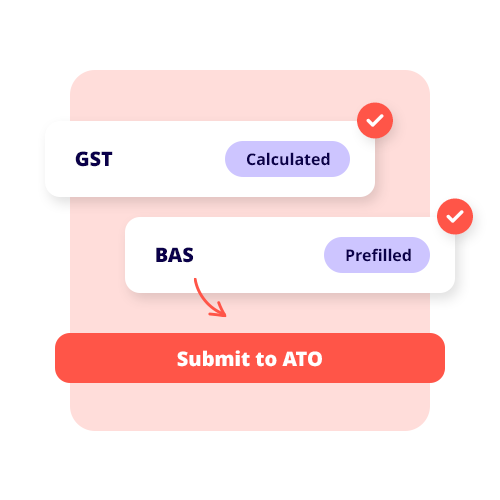Manage GST and lodge your BAS effortlessly
Automatically calculate GST and submit your business activity statement BAS straight to the ATO, making tax time easy!

Easily track, prepare and
lodge BAS
Reckon One business activity statement software automatically calculates GST as you go and prefills BAS, which makes doing your tax and preparing your business activity statement a breeze! You’ll always know how much you owe and when it’s due, so you’re ready to lodge your business activity statements BAS quickly and easily.


Manage GST transactions like
a pro
Track and manage GST transactions like a pro from the get-go. Reckon allows you to see individual transactions and business expenses that make up the GST totals in your business activity statements, as well as make GST adjustments from your BAS form as required – it’s GST information made easy!
Follow our step by step video tutorial for calculating your BAS figures in Reckon One.
Prepare tax reports for the ATO
Prepare your BAS reporting and PAYG & GST reports ready to submit to the ATO, on any device! You can keep track of their status and get your latest BAS from the ATO, saving you time and speeding up the BAS process!

Plans that fit your business needs and your pocket
30-DAY FREE TRIAL + SAVE 50% FOR 6 MONTHS ON ALL PLANS.
Payroll Essentials
For businesses with up to 4 employees
$6/ month
Was $12
Save $36 over 6 months
Up to 4 employees**
Process pay runs
Email payslips
Manage Single Touch Payroll
Calculate superannuation
Track leave & entitlements
Payroll reporting
Payroll companion app
Employee facing app
Track timesheets
Employee expense claims
Free data migration††
Free onboarding session
Advanced reporting
Payroll Plus
For businesses with up to 10 employees
$12.50 / month
Was $25
Save $72 over 6 months
Up to 10 employees**
Process pay runs
Email payslips
Manage Single Touch Payroll
Calculate superannuation
Track leave & entitlements
Payroll reporting
Payroll companion app
Employee facing app
Track timesheets
Employee expense claims
Free data migration††
Free onboarding session
Advanced reporting
Payroll Premium
For larger businesses
$25/ month
Was $50
Save $150 over 6 months
Unlimited employees**
Process pay runs
Email payslips
Manage Single Touch Payroll
Calculate superannuation
Track leave & entitlements
Payroll reporting
Payroll companion app
Employee facing app
Track timesheets
Employee expense claims
Free data migration††
Free onboarding session
Advanced reporting
† Transactions that exceed the 1000 limit will be subject to the BankData Fair Use Policy.
†† Free data migration offer includes 1 year of historical data + YDT only. Paid subscriptions only.
Helping thousands of businesses with their accounting
Frequently asked questions
Does a sole trader need to do BAS?
If you’re a sole trader and registered for GST, yes you will need to lodge a Business Activity Statement.
You must register for GST if:
- Your business has a GST turnover (gross income minus GST) of $75,000 or more per financial year
- Your non-profit organisation has a GST turnover of $150,000 or more per financial year
- You are a taxi driver and ride-sharing driver no matter what your turnover is
Our Reckon One BAS software for sole traders makes lodging your bas statement easy.
How do I prepare my BAS with Reckon One?
Reckon One makes lodging your BAS easy. Run the Reckon One “Activity Statement (BAS)” report that will help you generate the exact figures to enter onto your business activity statement form. Save and mark as lodged to help you stay organised. All Reckon accounting products are Simpler BAS enabled including Reckon One. Follow our step by step video tutorial for calculating your BAS figures in Reckon One.
How do I record a GST refund in Reckon One?
It’s easy to process a GST refund in Reckon One. Read our article here for the simple steps to follow.
We’ve also written a handy article that includes everything you need to know about GST refunds and claiming GST.
Try Reckon One free for 30 days
Cancel anytime.



